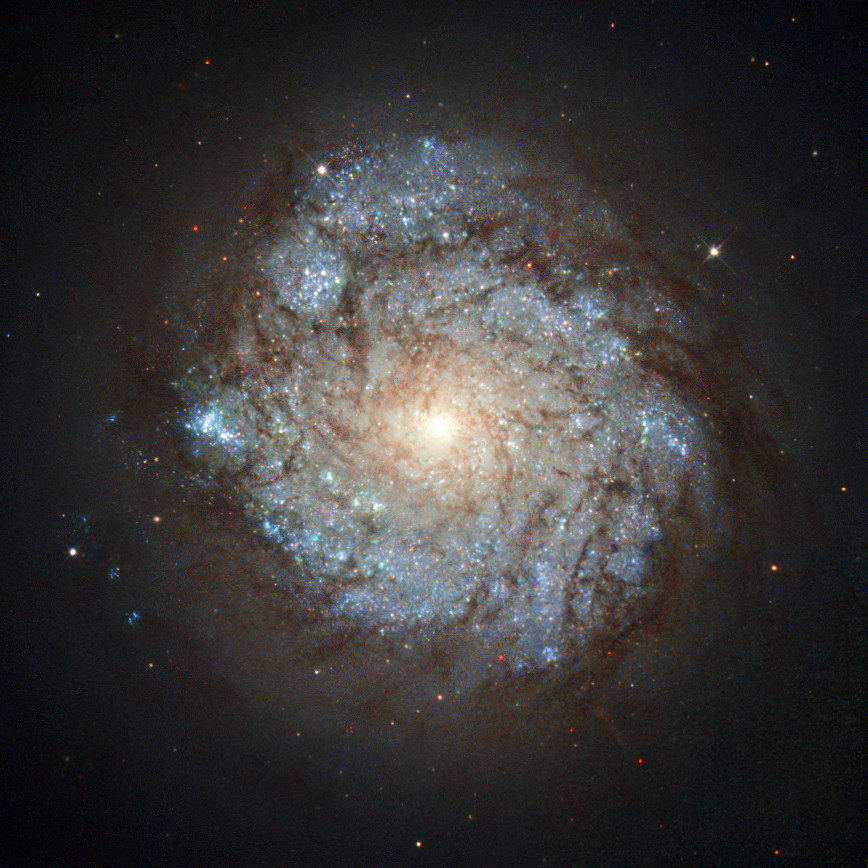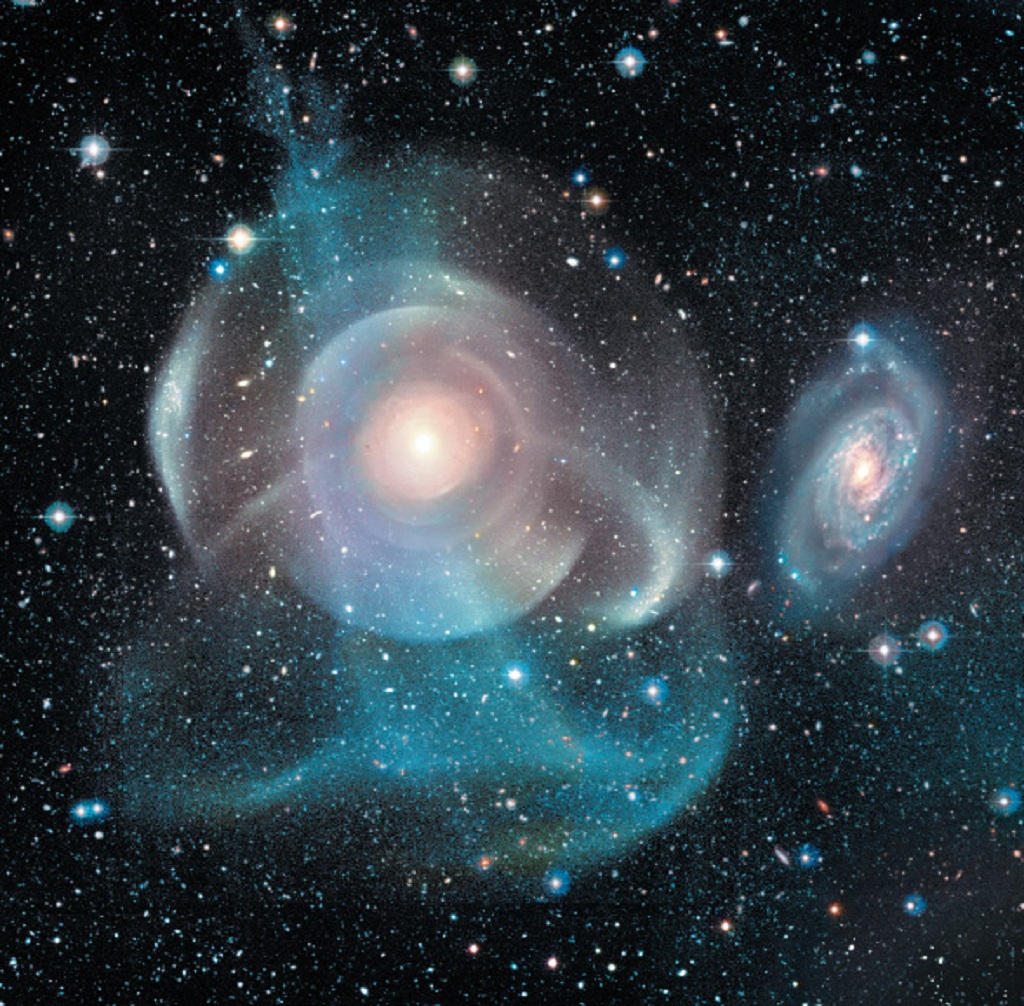Blog
https://www.youtube.com/watch?v=0LwaQbE-vzY
more...This image, taken by the NASA/ESA Hubble Space Telescope’s Wide Field Planetary Camera 2, shows a spiral galaxy named NGC 278. This cosmic beauty lies some 38 million light-years away in the northern constellation of Cassiopeia (The Seated Queen).
While NGC 278 may look serene, it is anything but. The galaxy is currently undergoing an immense burst of star formation. This flurry of activity is shown by the unmistakable blue-hued knots speckling the galaxy’s spiral arms, each of which marks a clump of hot newborn stars.
However, NGC 278’s star formation is somewhat unusual; it does not extend to the galaxy’s outer edges, but is only taking place within an inner ring some 6500 light-years across. This two-tiered structure is visible in this image — while the galaxy’s centre is bright, its extremities are much darker. This odd configuration is thought to have been caused by a merger with a smaller, gas-rich galaxy — while the turbulent event ignited the centre of NGC 278, the dusty remains of the small snack then dispersed into the galaxy’s outer regions. Whatever the cause, such a ring of star formation, called a nuclear ring, is extremely unusual in galaxies without a bar at their centre, making NGC 278 a very intriguing sight.

Youssou N’Dour (French pronunciation: [jusu (ɛ)nduʁ]; also known as Youssou Madjiguéne Ndour, born 1 October 1959) is a Senegalese singer, songwriter, composer, occasional actor, businessman, and politician. In 2004, Rolling Stone magazine described him as, “perhaps the most famous singer alive” in Senegal and much of Africa. From April 2012 to September 2013, he was Senegal’s Minister of Tourism.
N’Dour helped develop a style of popular Senegalese music known by all Senegambians (including the Wolof) as mbalax, a genre that has sacred origins in the Serer music njuup tradition and ndut initiation ceremonies. He is the subject of the award-winning films Return to Gorée (2007) directed by Pierre-Yves Borgeaud and Youssou N’Dour: I Bring What I Love (2008) directed by Elizabeth Chai Vasarhelyi, which were released around the world.
In 2006, N’Dour was cast as Olaudah Equiano in the film Amazing Grace.
more...Ellen McIlwaine (born October 1, 1945) is an American singer-songwriter and musician best known for her career as a solo singer, songwriter and slide guitarist.
Born in Nashville, Tennessee, United States, McIlwaine was adopted by missionaries and raised in Kobe, Japan, giving her exposure to multiple languages and cultures. She attended the Canadian Academy school in Kobe, graduating in 1963. Her first experience in music was playing Ray Charles, Fats Domino and Professor Longhair songs on piano that she heard on Japanese radio. On moving back to the United States she bought a guitar, beginning a stage career in Atlanta, Georgia in the mid-1960s.
In 1966, McIlwaine had a stint in New York City’s Greenwich Village where she opened every night at the Cafe Au Go Go, playing with Jimi Hendrix, and opening for Muddy Waters, Sonny Terryand Brownie McGhee, and Big Joe Williams. She returned to Atlanta to form the band Fear Itself, a psychedelic blues rock band.
more...Curtis Lundy (born October 1, 1955) is an American double bass player, composer, producer, choir director and arranger. Lundy is best known for his work as part of jazz vocalist Betty Carter‘s band.
more...Dave Holland (born 1 October 1946) is an English jazz double bassist, composer and bandleader who has been performing and recording for five decades. He has lived in the United States for over 40 years.
His work ranges from pieces for solo performance to big band. Holland runs his own independent record label, Dare2, which he launched in 2005. He has explained his musical philosophy by quoting fellow jazz artist Sam Rivers: “Sam said, ‘Don’t leave anything out – play all of it.'”
Holland has played with some of the greatest names in jazz, and has participated in several classic recording sessions.
Born in Wolverhampton, England, Holland taught himself how to play stringed instruments, beginning at four on the ukulele, then graduating to guitar and later bass guitar. He quit school at the age of 15 to pursue his profession in a pop band, but soon gravitated to jazz. After seeing an issue of Down Beat where Ray Brown had won the critics’ poll for best bass player, Holland went to a record store, and bought a couple of LPs featuring Brown backing pianist Oscar Peterson. He also bought two Leroy Vinnegar albums (Leroy Walks! and Leroy Walks Again) because the bassist was posed with his instrument on the cover. Within a week, Holland traded in his bass guitar for a double bass and began practicing with the records. In addition to Brown and Vinnegar, Holland was drawn to the bassists Charles Mingus and Jimmy Garrison.
more...Albert Gene Drewery, known as Albert Collins and the Ice Man (October 1, 1932 – November 24, 1993), was an American electric blues guitarist and singer with a distinctive guitar style. He was noted for his powerful playing and his use of altered tunings and a capo. His long association with the Fender Telecaster led to the title “The Master of the Telecaster”.
Collins was born in Leona, Texas, on October 1, 1932. He was introduced to the guitar at an early age by his cousin Lightnin’ Hopkins, also a Leona resident, who played at family gatherings. The Collins family relocated to Marquez, Texas, in 1938 and to Houston in 1941, where he attended Jack Yates High School. Collins took piano lessons when he was young, but when his piano tutor was unavailable his cousin Willow Young would lend Albert his guitar and taught him the altered tuning that he used throughout his career. Collins tuned his guitar to an open F-minor chord (FCFAbCF), with a capo at the 5th, 6th or 7th fret. At the age of twelve, he decided to concentrate on learning the guitar after hearing “Boogie Chillen’” by John Lee Hooker.
more...Franklin Joseph Lymon (September 30, 1942 – February 27, 1968) was an American rock and roll/rhythm and blues singer and songwriter, best known as the boy soprano lead singer of the New York City-based early rock and roll group The Teenagers. On February 27, 1968, Lymon was found dead of a heroin overdose at the age of 25 on the floor of his grandmother’s bathroom with a syringe by his side.
more...The Cartwheel Galaxy (also known as ESO 350-40 or PGC 2248) is a lenticular galaxy and ring galaxy about 500 million light-years away in the constellation Sculptor. It is an estimated 150,000 light-years diameter, and has a mass of about 2.9–4.8 × 109 solar masses; its outer ring has a circular velocity of 217 km/s.
It was discovered by Fritz Zwicky in 1941. Zwicky considered his discovery to be “one of the most complicated structures awaiting its explanation on the basis of stellar dynamics.” An estimation of the galaxy’s span resulted in a conclusion of 150,000 light years, which is slightly smaller than the Milky Way.
This galaxy resembles a bull’s eye, which is appropriate because its appearance is partly due to a smaller galaxy that passed through the middle of this object. The violent collision produced shock waves that swept through the galaxy and triggered large amounts of star formation. X-rays from Chandra (purple) show disturbed hot gas initially hosted by the Cartwheel galaxy being dragged over more than 150,000 light years by the collision. Optical data from Hubble (red, green, and blue) show where this collision may have triggered the star formation.

Patrice Louise Rushen (born September 30, 1954) is an American jazz pianist and R&B singer. She is also a composer, record producer, multi-instrumentalist, songwriter, and music director.
Her 1982 single, “Forget Me Nots“, received a Grammy Award nomination for Best Female R&B Vocal Performance. The instrumental “Number One” from her album Straight from the Heart earned an additional Grammy nomination for best instrumental. Her 12th album, Signature, also received a Grammy nomination for best instrumental in 1998.
Rushen also serves as an ambassador for artistry in education at the Berklee College of Music and the chair of the popular music program at the USC Thornton School of Music.
Rushen is the elder of two daughters born to Allen and Ruth Rushen. Patrice was three years old when she began playing the piano, and by the time she was six she was giving classical recitals. In her teens, she attended south LA’s Locke High School and went on to earn a degree in music from the University of Southern California.
After winning a competition at the age of 17 that enabled her to perform with her band at the Monterey Jazz Festival, Rushen signed with the Prestige label, releasing three albums with them – Prelusion (1974), Before the Dawn (1975), and Shout It Out (1977). In 1978, when she was 23, she began recording with Elektra.
more...Marc Bolan (/ˈboʊlən/ BOH-lən; born Mark Feld; 30 September 1947 – 16 September 1977) was an English singer, songwriter, musician, record producer, and poet. He was the lead singer of the band T. Rex and was one of the pioneers of the glam rock movement of the 1970s.
Bolan’s appearance on the BBC’s music show Top of the Pops in March 1971, wearing glitter and satins, is often cited as the beginning of the glam rock movement. Music critic Ken Barnes called Bolan “the man who started it all”. T. Rex’s 1971 album Electric Warrior, with all songs written by Bolan, including the UK chart topper “Get It On“, has been described by AllMusic as “the album that essentially kick-started the UK glam rock craze.”Producer Tony Visconti, who would also work with another major glam rock pioneer David Bowie, stated, “What I saw in Marc Bolan had nothing to do with strings, or very high standards of artistry; what I saw in him was raw talent. I saw genius. I saw a potential rock star in Marc – right from the minute, the hour I met him.”
Bolan died at the age of 29 in a car crash two weeks before his 30th birthday. In 1977, a memorial stone and bust of Bolan, Marc Bolan’s Rock Shrine, was unveiled at the site where he died in Barnes, London. As a member of T. Rex, Bolan will be posthumously inducted into the Rock and Roll Hall of Fame in 2020. On 16 September 1977, Bolan was riding in a Mini 1275GT driven by Gloria Jones as they headed home from Mortons club and restaurant in Berkeley Square. After she crossed a small humpback bridge near Gipsy Lane on Queens Ride, Barnes, southwest London, the car struck a fence post and then a tree. Bolan was killed instantly, while Jones suffered a broken arm and broken jaw.
more...Oscar Pettiford (September 30, 1922 – September 8, 1960) was an American jazz double bassist, cellist and composer. He was one of the earliest musicians to work in the bebop idiom.
Pettiford was born at Okmulgee, Oklahoma. His mother was Choctaw, and his father was half Cherokee and half African American.
He grew up playing in the family band in which he sang and danced before switching to piano at the age of 12, then to double bass when he was 14. He is quoted as saying he did not like the way people were playing the bass so he developed his own way of playing it. Despite being admired by the likes of Milt Hinton at the age of 14, he gave up in 1941 as he did not believe he could make a living. Five months later, he once again met Hinton, who persuaded him to return to music.
In 1942 he joined the Charlie Barnet band and in 1943 gained wider public attention after recording with Coleman Hawkins on his “The Man I Love“. Pettiford also recorded with Earl Hines and Ben Webster around this time. After he moved to New York, he was one of the musicians (together with Dizzy Gillespie, Thelonious Monk, Kenny Clarke) who in the early 1940s jammed at Minton’s Playhouse, where the music style developed that later was called bebop. He and Dizzy Gillespie led a bop group in 1943. In 1945 Pettiford went with Hawkins to California, where he appeared in The Crimson Canary, a mystery movie known for its jazz soundtrack, which also featured Josh White. He then worked with Duke Ellington from 1945 to 1948 and for Woody Herman in 1949 before working mainly as a leader in the 1950s. He died in 1960 in Copenhagen shortly before his 38th birthday, from a virus closely related to polio.
more...Bernard “Buddy” Rich (September 30, 1917 – April 2, 1987 NY,NY) was an American jazz drummer and bandleader. He is considered one of the most influential drummers of all time.
Rich was born and raised in Brooklyn, New York. He discovered his affinity for jazz music at a young age and began drumming at the age of 2. He began playing jazz in 1937, working with acts such as Tommy Dorsey, Count Basie, and Harry James. From 1942 to 1944, Rich served in the U.S. Marines. In 1966, he recorded a big-band style arrangement of songs from West Side Story. He found lasting success in 1967 with the formation of the Buddy Rich Big Band.
Rich was known for his virtuoso technique, power, and speed.[1] He was an advocate of the traditional grip, though he occasionally used match grip when playing the toms. Despite his commercial success and musical talent, Rich never learned how to read sheet music, preferring to listen to drum parts and play them from memory.
In 1987, Rich was admitted to the hospital after suffering a paralysis on his left side. Doctors later discovered and removed a malignant brain tumor. He died on April 2, 1987 at the age of 69, and was buried in Westwood Village Memorial Park Cemetery in Los Angeles, California.
more...Arp 227 consists of two galaxies in the constellation Pisces: the large (250,000 light-years across) lenticular galaxy NGC 474 (also known as UGC 864) located about 93 million light-years away, and the spiral galaxy NGC 470 at about 95 million light-years away. They lie at a separation of about 160,000 light-years.
Astronomers detected two additional members of the group which indicates that the pair constitutes the dominant members of a loose group. Evidence also suggests that Arp 227 is an evolving group in the early phase of its evolution and that its drivers are the accretion of faint galaxies and the ongoing large-scale interaction between NGC 470 and 474.
There is a tidal tail of gas and dust that connects NGC 474 to NGC 470, showing that the two are currently undergoing interaction. The low X-ray luminosity of NGC 470 seems to be a characteristic of dynamically young systems.
NGC 474 is a classic shell galaxy. These are usually the result of a merger though there’s no evidence of this in this case. All stars in it have a common motion. Normally if there’s a recent merger there are two families of stellar motion evident in the galaxy. That isn’t the case here.
The origin of the faint, wide arcs or shells of NGC 474 could have been formed by a gravitational encounter with NGC 470. But if NGC 470 caused the distortions in 474 why isn’t it similarly distorted as its mass appears less it should be even more torn up? This remains unknown.

More Posts
- Larry Carlton
- Eddie Lockjaw Davis
- Desi Arnaz
- Kurt Weill
- World Music CUBAGUAY
- Daily Roots Jerry Johnson
- Temple Israel Erev Shabbat Service 3-1-24
- Cosmos NGC 7293
- Burning Spear
- Ralph Towner
- Harry Belafonte
- Frédéric Chopin
- Flamenco Fridays Peret
- Daily Roots Wayne Jarrett
- Lao Tzu Wisdom
- Happy Leap Year 2024
- Cosmos M81
- Khaled
- Richie Cole
- Jimmy Dorsey